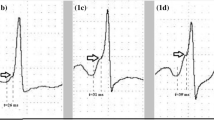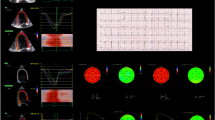Abstract
This study was conducted to evaluate the accuracy of exercise testing for predicting accessory pathway characteristics in children with Wolff–Parkinson–White (WPW) syndrome. The study enrolled 37 children with WPW syndrome and candidates for invasive electrophysiologic study (EPS). Exercise testing was performed for all the study participants before the invasive study. Data from the invasive EPS were compared with findings from the exercise testing. The sudden disappearance of the delta (Δ) wave was seen in 10 cases (27 %). No significant correlation was found between the Δ wave disappearance and the antegrade effective refractory period of the accessory pathway (AERP-AP) or the shortest pre-excited RR interval (SPERRI). The sensitivity, specificity, and positive and negative predictive values of Δ wave disappearance, based on AERP-AP as gold standard, were respectively 29.4, 80, 71.4, and 40 %. The corresponding values with SPERRI as the gold standard were respectively 23.8, 71.4, 71.4 and 23.8 %. Exercise testing has a medium to low rate of accuracy in detecting low-risk WPW syndrome patients in the pediatric age group.

Similar content being viewed by others
References
Bromberg BI, Lindsay BD, Cain ME, Cox JL (1996) Impact of clinical history and electrophysiologic characterization of accessory pathways on management strategies to reduce sudden death among children with Wolff–Parkinson–White syndrome. J Am Coll Cardiol 27:690–695
Campbell RM, Strieper MJ, Frias PA, Collins KK, Van Hare GF, Dubin AM (2003) Survey of current practice of pediatric electrophysiologists for asymptomatic Wolff–Parkinson–White syndrome. Pediatrics 111:6245–6247
Centurión OA, Shimizu A, Isomoto S, Konoe A (2008) Mechanisms for the genesis of paroxysmal atrial fibrillation in the Wolff–Parkinson–White syndrome: intrinsic atrial muscle vulnerability vs electrophysiological properties of the accessory pathway. Europace 10:294–302
Czosek RJ, Anderson JB, Marino BS, Mellion K, Knilans TK (2011) Noninvasive risk stratification techniques in pediatric patients with ventricular preexcitation. PACE 34:555–562
Dalili M, Rao JY, Brugada P (2013) Radiofrequency ablation of accessory pathways in children with complex congenital cardiac lesions: a report of three cases. J Tehran Heart Cent 8:111–115
Daubert C, Ollitrault J, Descaves C, Mabo P, Ritter P, Gouffault J (1988) Failure of the exercise test to predict the anterograde refractory period of the accessory pathway in Wolff–Parkinson–White syndrome. Pacing Clin Electrophysiol 11:1130–1138
Dubin AM, Collins KK, Chiesa N, Hanisch D, Van Hare GF (2002) Use of electrophysiologic testing to assess risk in children with Wolff–Parkinson–White syndrome. Cardiol Young 12:245–252
Duckeck W, Kuck KH (1993) Atrial fibrillation in Wolff–Parkinson–White syndrome: development and therapy. Herz 18:60–66
Fenici R, Ruggieri MP, di Lillo M, Fenici P (1996) Reproducibility of transesophageal pacing in patients with Wolff–Parkinson–White syndrome. Pacing Clin Electrophysiol 19:1951–1957
Friedman RA, Walsh EP, Silka MJ, Calkins H, Stevenson WG, Rhodes LA, Deal BJ, Wolff GS, Demaso DR, Hanisch D, Van Hare GF (2002) NASPE Expert Consensus Conference: radiofrequency catheter ablation in children with and without congenital heart disease: report of the writing committee, North American Society of Pacing and Electrophysiology. Pacing Clin Electrophysiol 25:1000–1017
Gaita F, Giustetto C, Riccardi R, Mangiardi L, Brusca A (1989) Stress and pharmacologic test as methods to identify patients with Wolff–Parkinson–White syndrome at risk of sudden death. Am J Card 64:487–490
Jezior MR, Kent SM, Atwood JE (2005) Exercise testing in Wolff–Parkinson–White syndrome: case report with ECG and literature review. Chest 127:1454–1457
Mosaed P, Dalili M, Emkanjoo Z (2012) Interventional electrophysiology in children: a single-center experience. Iran J Pediatr 22:333–338
Nielsen JC, Kottkamp H, Piorkowski C, Gerds-Li JH, Tanner H, Hindricks G (2006) Radiofrequency ablation in children and adolescents: results in 154 consecutive patients. EP Europace 8:323–329
Pappone C, Santinelli V, Rosanio S, Vicedomini G, Nardi S, Pappone A, Tortoriello V, Manguso F, Mazzone P, Gulletta S, Oreto G, Alfieri O (2003) Usefulness of invasive electrophysiologic testing to stratify the risk of arrhythmic events in asymptomatic patients with Wolff–Parkinson–White pattern: results from a large prospective long-term follow-up study. J Am Coll Cardiol 41:239–244
Pediatric and Congenital Electrophysiology Society (PACES), Heart Rhythm Society (HRS), American College of Cardiology Foundation (ACCF), American Heart Association (AHA), American Academy of Pediatrics (AAP), Canadian Heart Rhythm Society (CHRS), Cohen MI, Triedman JK, Cannon BC, Davis AM, Drago F, Janousek J, Klein GJ, Law IH, Morady FJ, Paul T, Perry JC, Sanatani S, Tanel RE (2012) PACES/HRS expert consensus statement on the management of the asymptomatic young patient with a Wolff–Parkinson–White (WPW, ventricular preexcitation) electrocardiographic pattern: developed in partnership between the Pediatric and Congenital Electrophysiology Society (PACES) and the Heart Rhythm Society (HRS). Endorsed by the governing bodies of PACES, HRS, The American College of Cardiology Foundation (ACCF), The American Heart Association (AHA), The American Academy of Pediatrics (AAP), and The Canadian Heart Rhythm Society (CHRS). Heart Rhythm 9: 1006–1024
Santinelli V, Radinovic A, Manguso F, Vicedomini G, Gulletta S, Paglino G, Mazzone P, Ciconte G, Sacchi S, Sala S, Pappone C (2009) The natural history of asymptomatic ventricular pre-excitation: a long-term prospective follow-up study of 184 asymptomatic children. J Am Coll Cardiol 53:275–280
Sarubbi B, D’Alto M, Vergara P, Calvanese R, Mercurio B, Russo MG, Calabrò R (2005) Electrophysiological evaluation of asymptomatic ventricular pre-excitation in children and adolescents. Int J Card 98:207–214
Sharma AD, Yee R, Guiraudon G, Klein GJ (1987) Sensitivity and specificity of invasive and noninvasive testing for risk of sudden death in Wolff–Parkinson–White syndrome. J Am Coll Cardiol 10:373–381
Wackel P, Irving C, Webber S, Beerman L, Arora G (2012) Risk stratification in Wolff–Parkinson–White syndrome: the correlation between noninvasive and invasive testing in pediatric patients. PACE 35:1451–1457
Author information
Authors and Affiliations
Corresponding author
Rights and permissions
About this article
Cite this article
Dalili, M., Vahidshahi, K., Aarabi-Moghaddam, M.Y. et al. Exercise Testing in Children With Wolff–Parkinson–White Syndrome: What Is Its Value?. Pediatr Cardiol 35, 1142–1146 (2014). https://doi.org/10.1007/s00246-014-0907-5
Received:
Accepted:
Published:
Issue Date:
DOI: https://doi.org/10.1007/s00246-014-0907-5




